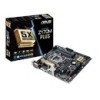Asus Z170M-PLUS User Guide - Page 66
Platform Misc Configuration, CFG Lock [Enabled], PCI-E Native Power Management [Disabled]
 |
View all Asus Z170M-PLUS manuals
Add to My Manuals
Save this manual to your list of manuals |
Page 66 highlights
The following items appear only when you set the CPU C-States to [Enabled]. Enhanced C states [Enabled] This item allows your CPU to reduce power consumption when the system is in idle mode. Configuration options: [Enabled] [Disabled] CPU C3/C6 Report [Enabled] Allows you to disable or enable the CPU C3/C6 report to OS. Configuration options: [Enabled] [Disabled] Package C State Limit [Auto] This item allows you to set the a C-state support for the CPU package. Configuration options: [Auto] [C0/C1] [C2] [C3] [C6] [C7] [C7s] CFG Lock [Enabled] This item allows you to configure MSR 0xE2[15], CFG lock bit. Configuration options: [Disabled] [Enabled] 2.6.2 Platform Misc Configuration The items in this menu allow you to configure the platform-related features. PCI-E Native Power Management [Disabled] This item allows you to enhance the power saving feature of PCI Express and perform ASPM operations in the operating system. Configuration options: [Disabled] [Enabled] The following item appears only when you set the PCI Express Native Power Management to [Enabled]. Native ASPM [Disabled] [Enabled] Windows® Vista OS controls the ASPM (active state power management) support for devices. [Disabled] BIOS controls the ASPM support for the device. PCH - PCI Express options DMI Link ASPM Control [Disabled] This item allows you to control the Active State Power Management on both NB (NorthBridge) side and SB (SouthBridge) side of the DMI Link. Configuration options: [Disabled] [Enabled] ASPM Support [Disabled] This item allows you to select the ASPM state for energy-saving conditions. Configuration options: [Disabled] [L0s] [L1] [L0sL1] [Auto] 2-32 Chapter 2: Getting started















